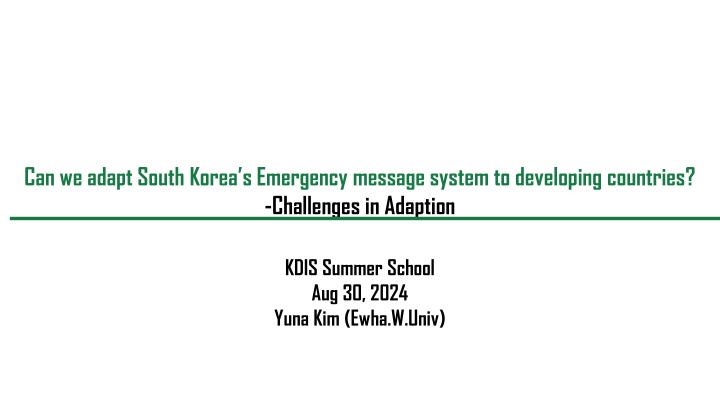
Adapting South Korea's Emergency Message System for Developing Countries
Explore the challenges and potential methods of adapting South Korea's advanced Early Warning System to developing countries, focusing on key factors such as infrastructure, institutional capacity, and environmental differences. Learn from existing literature and research questions to enhance disaster prevention and management worldwide.
Download Presentation

Please find below an Image/Link to download the presentation.
The content on the website is provided AS IS for your information and personal use only. It may not be sold, licensed, or shared on other websites without obtaining consent from the author. If you encounter any issues during the download, it is possible that the publisher has removed the file from their server.
You are allowed to download the files provided on this website for personal or commercial use, subject to the condition that they are used lawfully. All files are the property of their respective owners.
The content on the website is provided AS IS for your information and personal use only. It may not be sold, licensed, or shared on other websites without obtaining consent from the author.
E N D
Presentation Transcript
Can we adapt South Koreas Emergency message system to developing countries? -Challenges in Adaption KDIS Summer School Aug 30, 2024 Yuna Kim (Ewha.W.Univ)
Motivation Source: United Nations Office for Disaster Risk Reduction (UNDRR) Source: World Meteological Organization) Disaster-related casualties are concentrated in underdeveloped countries. However, only half of the countries worldwide have implemented Multi-Hazard Early Warning Systems (MHEWS), showing a highly uneven distribution across regions. (UNDRR, Global status of mylti-hazard early warning system, 2023) The number of recorded disasters over the past 50 years has increased fivefold due to human-induced climate change and other factors, and this trend is expected to continue. (Un News, WMO report, 2021)
Existing Literature Other countries Disaster information delivery media there are regional differences in the adoption of modern information and communication technologies, including traditional media such as radio and TV channels. In many regions, traditional media still dominate. A typhoon warning is in effect from 23:00 today. Please avoid coastal areas, evacuate ships, and refrain from activities that could damage agricultural and marine products. Korea s effective emergency message system Due to the COVID-19 pandemic, the frequency of emergency alert messages has increased significantly, leading to heightened interest in these alerts. Consequently, discussions are taking place regarding the effectiveness of emergency alerts and their impact on disaster prevention. The study Economic Analysis of Emergency Alerts by Heon-Jae Song and Ha-Young Cho concludes that sending one additional emergency alert can reduce natural disaster recovery costs by approximately 100 million KRW.
Research Questions & Methods 1. Can we adapt South Korea s Early Warning System to developing countries? 2. Challenges and Issues in Transplanting EWS to Cambodia, Focusing on Different Environments Compared to Korea -Infrastructure Differences - Institutional Capacity -Climate and Environmental Factors 3. Methodology -Surveys -Interview
